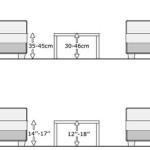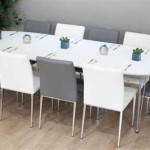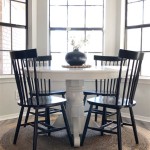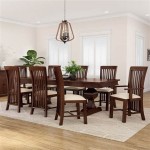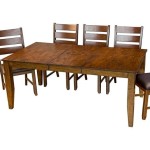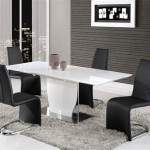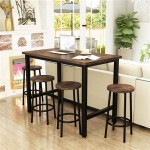```html
The Enduring Appeal of the 4-Leg Round Dining Table
The 4-leg round dining table stands as a classic and versatile furniture choice for a wide range of homes. Its design, characterized by a circular tabletop supported by four legs, offers a blend of aesthetic appeal and practical functionality. This article will examine the enduring popularity of the 4-leg round dining table, exploring its various advantages, design considerations, material options, and suitability for different spaces.
Space Efficiency and Social Dynamics
One of the key advantages of a round dining table is its efficient use of space, particularly in smaller dining areas. Unlike rectangular or square tables, round tables lack sharp corners, which allows for smoother traffic flow around the table. This is particularly beneficial in apartments or homes where space is limited. The absence of corners also creates a more intimate and inclusive dining experience. Everyone seated at a round table is equidistant from the center, facilitating conversation and fostering a sense of equality. This egalitarian seating arrangement promotes better interaction and encourages a more collaborative atmosphere during meals or gatherings.
Furthermore, the circular shape allows for easier accommodation of extra guests. By simply squeezing chairs closer together, a round table can often comfortably accommodate one or two additional people without disrupting the flow of conversation or making guests feel cramped. This adaptability is especially useful for informal gatherings or unexpected visitors. The visual appeal of a round table can also contribute to a sense of openness and spaciousness in a room. The continuous curve of the tabletop draws the eye around the room, creating a feeling of flow and preventing the space from feeling boxy or confined.
The placement of a 4-leg round dining table is also relatively flexible. It can be positioned in the center of a room or placed against a wall to maximize space. In a square room, a round table can soften the angular lines and create a more balanced aesthetic. In a rectangular room, it can add a touch of visual interest and prevent the space from feeling too elongated. The versatility of its placement contributes to its overall appeal and adaptability to various room layouts.
Design Considerations and Material Choices
The design of a 4-leg round dining table can vary significantly, offering a wide range of styles to suit diverse tastes and interior decor preferences. The leg design, in particular, plays a crucial role in determining the overall aesthetic of the table. Straight, tapered legs offer a clean and modern look, while turned or carved legs add a touch of traditional elegance. Pedestal bases are also an alternative, offering a different aesthetic and potentially more legroom, although they technically deviate from the 4-leg configuration.
The choice of materials further influences the table's style and durability. Wood is a classic and popular choice, offering a warm and inviting feel. Different types of wood, such as oak, maple, walnut, and cherry, offer varying grains, colors, and hardness levels. Oak is known for its durability and distinctive grain pattern, while walnut is prized for its rich, dark color and elegant appearance. Maple provides a lighter and more neutral tone, while cherry offers a warm and reddish hue. The finish applied to the wood can also significantly alter its appearance, ranging from a natural oil finish that highlights the wood's grain to a painted finish that provides a more contemporary look.
Glass tabletops offer a sleek and modern aesthetic. They can be clear, frosted, or tinted, and are often paired with metal or wood bases. Glass is easy to clean and maintain, but it can be susceptible to scratches and fingerprints. Stone tabletops, such as marble or granite, offer a luxurious and durable option. They are heat-resistant and scratch-resistant, but they can be heavy and expensive. Laminate tabletops provide a cost-effective alternative to wood, glass, or stone. They are available in a wide range of colors and patterns, and they are relatively easy to clean. However, laminate is less durable than other materials and can be prone to chipping or peeling.
The size of the table should be carefully considered based on the size of the dining area and the number of people who will typically be using it. A smaller round table, typically 36-48 inches in diameter, is suitable for seating two to four people, while a larger round table, typically 54-72 inches in diameter, can comfortably accommodate six to eight people. It is important to allow sufficient space around the table for chairs to be pulled out and for people to move around comfortably. A general guideline is to allow at least 36 inches of space between the edge of the table and any walls or other furniture.
Matching Style and Practicality
The 4-leg round dining table can seamlessly integrate into various interior design styles, from traditional to contemporary. In a traditional setting, a wooden table with turned legs and a rich finish can complement other classic furniture pieces. Pair it with upholstered chairs in a traditional fabric, such as damask or brocade, to create a formal and elegant dining space. Add a chandelier and some framed artwork to complete the look.
For a more modern aesthetic, opt for a table with clean lines and a minimalist design. A glass or metal tabletop paired with simple, metal legs can create a sleek and contemporary feel. Pair it with modern chairs in a bold color or a geometric design. Add a statement pendant light and some abstract artwork to create a contemporary dining space.
In a rustic or farmhouse setting, a wooden table with a distressed finish and chunky legs can create a warm and inviting atmosphere. Pair it with mismatched chairs in various styles and finishes. Add a woven rug and some vintage accessories to complete the look. A round table can soften the hard lines often associated with farmhouse style, adding a touch of warmth and informality.
Beyond aesthetics, practicality is a key consideration. The durability of the chosen material is crucial, particularly in homes with children or pets. The table's finish should be resistant to scratches, stains, and water damage. Regular cleaning and maintenance are also essential to keep the table looking its best. Wood tables should be cleaned with a mild soap and water solution and occasionally polished to protect the finish. Glass tables should be cleaned with a glass cleaner to remove fingerprints and smudges. Stone tables should be sealed to prevent staining and cleaned with a pH-neutral cleaner.
The 4-leg round dining table represents a timeless choice that balances form and function. Its adaptability to different spaces, styles, and needs makes it a popular selection for homeowners seeking a versatile and aesthetically pleasing dining solution. Careful consideration of design elements and and material choices can ensure the round dining table perfectly complements any interior design scheme.
```
48 Round Emerado Solid Wood Leg Dining Table From Dutchcrafters

Round 4 Leg Table

Standard Finish Top 4 Legs Dining Table Round Craftwork Contract Furniture

Byblight Roesler Farmhouse Burlywood Wood 47 In 4 Legs Round Dining Table Small Kitchen Seats Bb Xk00546xhy

Rent The Beaumont Round Dining Table Cort Furniture Rental

Round Sanford Leg Dining Table From Dutchcrafters Amish Furniture

Noble House Kirs Modern Light Ash Brown Wood Top 46 85 In 4 Legs Round Dining Table Seat 114615

5 Piece Small Dining Table Set For 4 Round Room With Upholstered Chairs Oak Legs Apartment Indoor Furniture Maison Boucle

Zerifevni 46 4 Mid Century Modern Dining Set Small Space Saver 1 Table White Chairs Walmart Com

Wiltshire Farmhouse 4 Leg Round Pedestal Table 90cm 100cm 110cm 120cm Etsy

